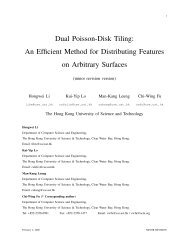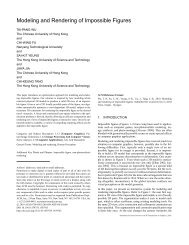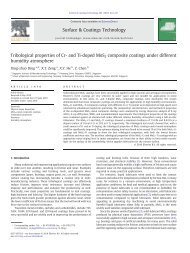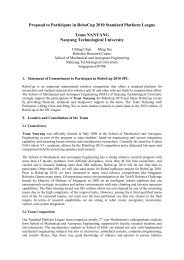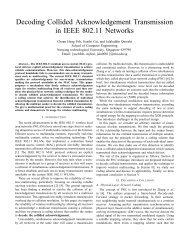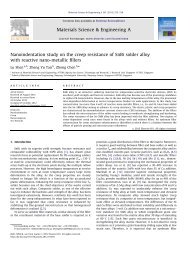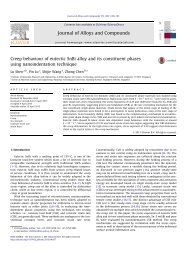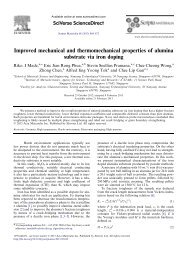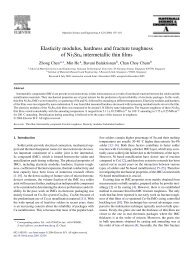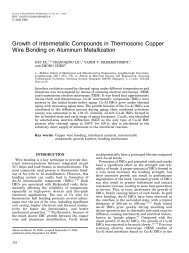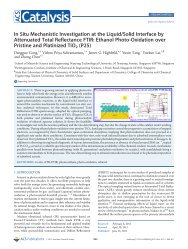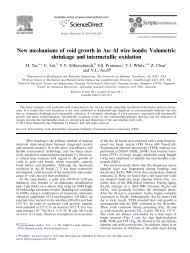Formation and migration of oxygen and zirconium vacancies in ...
Formation and migration of oxygen and zirconium vacancies in ...
Formation and migration of oxygen and zirconium vacancies in ...
You also want an ePaper? Increase the reach of your titles
YUMPU automatically turns print PDFs into web optimized ePapers that Google loves.
formation <strong>of</strong> bulk <strong>zirconium</strong> <strong>and</strong> <strong>oxygen</strong> gas condition (3) has to be conserved<br />
(otherwise the oxide is unstable).<br />
ΔμZr ¼ μZr−μ bulk<br />
Zr ≤ 0<strong>and</strong>ΔμO ¼ μO−EO gas =2≤0 ð3Þ<br />
For the thermodynamically stable ZrOS, the variations <strong>of</strong> elemental<br />
chemical potentials (Δμ i) are restricted by Eq.(4) <strong>and</strong> formation <strong>of</strong><br />
compet<strong>in</strong>g phases such as c-ZrO2 or ZrS2 accord<strong>in</strong>g to Eqs. (5), (6)<br />
ΔH ZrOS ¼ Δμ Zr þ Δμ O þ Δμ S<br />
ΔH с−ZrO2 ¼ Δμ Zr þ 2Δμ O ð5Þ<br />
ΔH ZrS2 ¼ Δμ Zr þ 2Δμ S ð6Þ<br />
where ΔHZrOS, <strong>and</strong> ΔHZrS 2 are calculated formation heats <strong>of</strong> ZrOS<br />
(−8.55 eV), <strong>and</strong> ZrS 2 (−4.70 eV), respectively. These conditions determ<strong>in</strong>e<br />
the phase diagram shown <strong>in</strong> Fig. 2. It can be seen that<br />
undoped zirconia is thermodynamically stable over a wide range <strong>of</strong><br />
chemical potentials. However, the comb<strong>in</strong>ation <strong>of</strong> low <strong>oxygen</strong> <strong>and</strong><br />
high sulfur partial pressures may result <strong>in</strong> the stabilization <strong>of</strong> ZrOS.<br />
In Fig. 2 the gray shaded area represents the chemical stability<br />
range <strong>of</strong> ZrOS. It should be noted that l<strong>in</strong>e through po<strong>in</strong>ts C <strong>and</strong> D<br />
(calculated by us<strong>in</strong>g Eqs. 4 <strong>and</strong> 6) corresponds to coexistence conditions<br />
<strong>of</strong> ZrOS <strong>and</strong> ZrS 2 structures. Whereas, l<strong>in</strong>e through po<strong>in</strong>ts A<br />
<strong>and</strong> B (calculated by us<strong>in</strong>g Eqs. 4, <strong>and</strong> 5) corresponds to the coexistence<br />
conditions <strong>of</strong> c-ZrO 2 <strong>and</strong> ZrOS structures. Based on these results,<br />
the defect calculations have been performed for two extreme<br />
conditions: <strong>oxygen</strong>-rich limit (po<strong>in</strong>t A, ΔμO=−3.42 eV) <strong>and</strong><br />
<strong>oxygen</strong>-poor limit (po<strong>in</strong>t B, ΔμO=−5.99 eV). This range <strong>of</strong> <strong>oxygen</strong><br />
chemical potential (ΔμO) is different from that for c-ZrO2 at low sulfur<br />
partial pressure (0 eV>ΔμO >Hc-ZrO 2 /2), therefore our results under<br />
<strong>oxygen</strong>-rich limit cannot be compared with previously reported data.<br />
3.2. <strong>Formation</strong> <strong>of</strong> <strong>zirconium</strong> <strong>and</strong> <strong>oxygen</strong> <strong>vacancies</strong> <strong>in</strong> ZrOS<br />
<strong>and</strong> c-ZrO 2 structures<br />
Details <strong>of</strong> the atomistic displacements (with reference to the perfect<br />
crystals) surround<strong>in</strong>g different <strong>vacancies</strong> <strong>in</strong> both bulk c-ZrO2 <strong>and</strong><br />
ZrOS are shown <strong>in</strong> Table 2, where NN Zr (NN O, <strong>and</strong> NN S) is the<br />
Fig. 2. Stability diagram for ZrOS as determ<strong>in</strong>ed from DFT calculations. The area conf<strong>in</strong>ed<br />
between po<strong>in</strong>ts A (Δμ O=−3.42 eV, Δμ Zr=−5.13 eV, Δμ S=0 eV), B(Δμ O=<br />
−5.99 eV, Δμ Zr=0 eV, Δμ S=−2.56 eV), C (Δμ O=−6.20 eV, Δμ Zr =0 eV, Δμ S=<br />
−2.35 eV), <strong>and</strong> D (ΔμO=−3.75 eV, ΔμZr=−4.70 eV, ΔμS=0 eV) is the chemical stability<br />
range <strong>of</strong> ZrOS. The l<strong>in</strong>e through po<strong>in</strong>ts C <strong>and</strong> B corresponds to the maximally<br />
<strong>zirconium</strong>-rich conditions (Δμ Zr=0 eV). Along l<strong>in</strong>es parallel to C–B the <strong>zirconium</strong><br />
chemical potential is constant.<br />
2<br />
O.I. Malyi et al. / Solid State Ionics 212 (2012) 117–122<br />
ð4Þ<br />
Table 2<br />
Structure relaxation <strong>of</strong> ions neighbor<strong>in</strong>g the vacancy site (only <strong>in</strong>formation for nearest<br />
neighbors (NN) is shown)(‘−’/‘+’ means <strong>in</strong>ward/outward displacement to the vacancy).<br />
VO 0<br />
VO +1<br />
VO +2<br />
VZr<br />
0<br />
− 1<br />
VZr<br />
− 2<br />
VZr<br />
− 3<br />
VZr<br />
− 4<br />
VZr<br />
For ZrO 2<br />
NN O −0.083 −0.251 −0.241 0.141 0.146 0.153 0.157 0.163<br />
NN Zr −0.028 0.194 0.196 −0.068 −0.075 −0.077 −0.082 −0.084<br />
For ZrOS<br />
NNO 0.028 0.044 0.064 0.138 0.133 0.127 0.123 0.120<br />
NNZr 0.044 0.174 0.322 −0.050 −0.054 −0.059 −0.066 −0.086<br />
NNS −0.108 −0.166 −0.282 −0.006 0.013 0.020 0.036 0.078<br />
displacements <strong>of</strong> the <strong>zirconium</strong> (<strong>oxygen</strong>, <strong>and</strong> sulfur) atoms occupy<strong>in</strong>g<br />
the nearest-neighbor (NN) sites to the vacancy. For c-ZrO 2, it is<br />
shown that formation <strong>of</strong> the neutral <strong>oxygen</strong> vacancy (VO 0 ) causes<br />
small (0.083 Å for O, <strong>and</strong> 0.028 Å for Zr) <strong>in</strong>ward displacements <strong>of</strong><br />
the neighbor<strong>in</strong>g <strong>zirconium</strong> <strong>and</strong> <strong>oxygen</strong> ions. Whereas, for positively<br />
charged <strong>oxygen</strong> <strong>vacancies</strong> (V O +1 , <strong>and</strong> VO +2 ) the Zr ions near the vacancy<br />
displace outwards by 0.194–0.196 Å, this strong relaxation is<br />
caused by the fact that the neighbor<strong>in</strong>g Zr ions lose part <strong>of</strong> the screen-<br />
<strong>in</strong>g effect provided by electrons <strong>in</strong> the neutral vacancy case. Forma-<br />
0<br />
tion <strong>of</strong> neutral <strong>zirconium</strong> vacancy (VZr) results <strong>in</strong> the repulsion felt<br />
by the <strong>oxygen</strong> ions <strong>and</strong> strong outward displacement (0.141 Å) <strong>of</strong><br />
the neighbor<strong>in</strong>g <strong>oxygen</strong> ions. These results agree well with those<br />
reported for m-ZrO2.[23] For ZrOS, the directions <strong>of</strong> atomistic displacement<br />
are the same with those for c-ZrO2, but the absolute values<br />
<strong>of</strong> displacements are somewhat different. For <strong>in</strong>stance, for VO +2 <strong>in</strong><br />
ZrOS Zr ions surround<strong>in</strong>g the vacancy displace outwards by 0.322 Å,<br />
which is 0.126 Å higher than that for c-ZrO2.<br />
The formation energies <strong>of</strong> <strong>oxygen</strong> <strong>and</strong> <strong>zirconium</strong> <strong>vacancies</strong> <strong>in</strong> c-<br />
ZrO2 <strong>and</strong> ZrOS structures for two limit<strong>in</strong>g values <strong>of</strong> <strong>oxygen</strong> chemical<br />
potentials (<strong>oxygen</strong>-rich limit (ΔμO=−3.42 eV) <strong>and</strong> <strong>oxygen</strong>-poor<br />
limit (ΔμO=−5.99 eV)) are shown <strong>in</strong> two forms: 1) at VBM (Ef=0)<br />
(see Table 3); 2) as a function <strong>of</strong> the Fermi level (Ef) (see Fig. 3). In<br />
Fig. 3 the lowest limit <strong>of</strong> the Fermi level (Ef) represents the VBM,<br />
whereas the upper limit <strong>of</strong> Ef corresponds to the bottom <strong>of</strong> the calculated<br />
conduction b<strong>and</strong> (BCCB). Only the <strong>vacancies</strong> among the lowest<br />
formation energies are shown. Due to the large formation heats <strong>of</strong><br />
c-ZrO2 <strong>and</strong> ZrOS structures defect formation energies strongly vary<br />
between the po<strong>in</strong>ts A <strong>and</strong> B <strong>of</strong> the phase diagram (see Fig. 3). In<br />
both systems defect formation energies (ΔHD,q) become negative at<br />
some Ef which determ<strong>in</strong>es p<strong>in</strong>n<strong>in</strong>g energy(εp<strong>in</strong>) [58].<br />
Next we analyze stability <strong>of</strong> <strong>oxygen</strong> <strong>and</strong> <strong>zirconium</strong> <strong>vacancies</strong> <strong>in</strong><br />
c-ZrO2. For <strong>oxygen</strong>-poor conditions, <strong>oxygen</strong> vacancy <strong>in</strong> doubly positively<br />
+2 +<br />
charged state (VO )isstableatEfbεp<strong>in</strong>. While <strong>in</strong>crease <strong>of</strong> the Fermi<br />
level (Ef) to BCCB makes neutral <strong>oxygen</strong> vacancy the dom<strong>in</strong>ant defect.<br />
For these conditions formation <strong>of</strong> <strong>zirconium</strong> <strong>vacancies</strong> is unlikely due<br />
to high defect formation energy. Increas<strong>in</strong>g the <strong>oxygen</strong> chemical potential<br />
reduces the stability <strong>of</strong> <strong>oxygen</strong> <strong>vacancies</strong> (<strong>in</strong>creases their formation<br />
energy) <strong>and</strong> <strong>in</strong>creases stability <strong>of</strong> <strong>zirconium</strong> <strong>vacancies</strong> (decreases their<br />
+2<br />
formation energies): VO still can form spontaneously near VBM, but<br />
-<br />
) <strong>zirconium</strong> <strong>vacancies</strong> (VZr −4 )aresta-<br />
for the higher Fermi level (Ef>εp<strong>in</strong><br />
ble. It should also be noted that <strong>oxygen</strong> <strong>vacancies</strong> <strong>in</strong> c-ZrO2 show a “negative-U”<br />
behavior, <strong>in</strong> other words, VO +1<br />
is not stable aga<strong>in</strong>st<br />
disproportionation <strong>in</strong>to V O <strong>and</strong> V O +2 . For ZrOS structure, VO +2 is also<br />
the most stable type <strong>of</strong> <strong>vacancies</strong> at VBM (see Table 3), <strong>and</strong> it can spontaneously<br />
form under <strong>oxygen</strong>-poor conditions (see Fig. 3). But, under<br />
<strong>oxygen</strong>-poor limit VO +1 is stable <strong>in</strong> ZrOS structure at 0.46 eV≥<br />
E f≥1.50 eV, while <strong>in</strong> c-ZrO 2 it is the metastable defect (see Fig. 3b).<br />
This suggests that the “negative-U” behavior is not typical for <strong>oxygen</strong><br />
<strong>vacancies</strong> (V O 0 ,VO +1 , <strong>and</strong> VO +2 ) <strong>in</strong> ZrOS. Similar to the c-ZrO2, <strong>in</strong>creas<strong>in</strong>g<br />
the <strong>oxygen</strong> chemical potential can make VZr −4 stable close to BCCB. Analysis<br />
<strong>of</strong> Fig. 3 can also provide some <strong>in</strong>formation on the nature <strong>of</strong> <strong>oxygen</strong><br />
<strong>and</strong> <strong>zirconium</strong> <strong>vacancies</strong> <strong>in</strong> c-ZrO2 <strong>and</strong> ZrOS structures. For both structures,<br />
formation energy <strong>of</strong> <strong>oxygen</strong> <strong>vacancies</strong> <strong>in</strong>creases with <strong>in</strong>creas<strong>in</strong>g<br />
119



